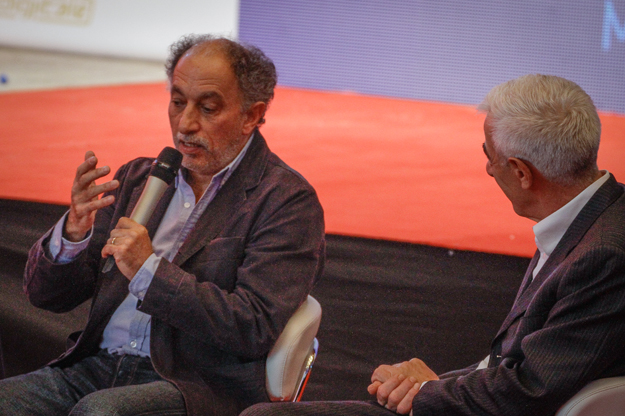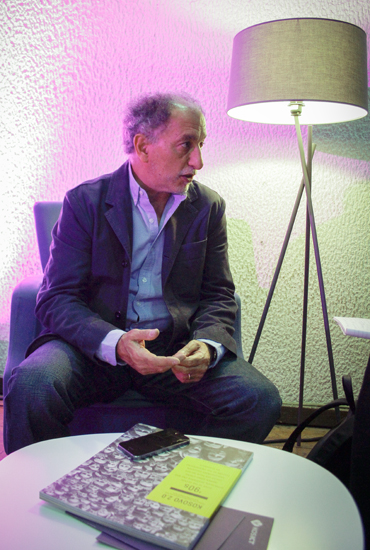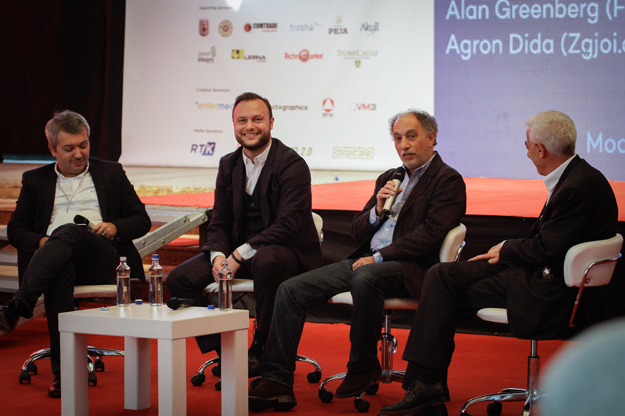“I don’t care about being liked. I want to be respected,” says Alan Greenberg, a world leader in education technology and innovation, as he explains what he calls the ‘Greenberg technique,’ to K2.0. Young developers and startups need to be able to explain their product in 30 seconds in order to grab his attention, otherwise he moves on. “If they aren’t able to explain in 30 seconds what they are doing and what it will change, it will fail.”
Greenberg was demonstrating his technique on participants in the Startup Fair at the fifth edition of the KOSICT Tech festival, which was held in Prishtina last week. The conference was organized by the Kosovo Association of Information and Communication Technology (STIKK) with support from Innovation Centre Kosovo (ICK) and Universum University College. It featured talks on a number of global trending topics in IT; from digital marketing to education technology and e-sports.
Greenberg, who managed Apple’s Higher Education business in Europe and Asia between 2004 and 2009, was one of the most prominent KOSICT speakers during the two-day conference, that gathered international speakers from the tech world. He is now an investor, consultant and sometime mentor to a number of tech companies from across the globe. His portfolio includes companies from New York to London to Beijing.
For over a decade, his focus has been on education technology. His presentation at KOSICT included an introduction to ed-tech apps that have already found a place in the classroom and new apps that are being developed with the aim of further revolutionizing digital learning. K2.0 caught up with him after this presentation to discuss how technology can improve education, how the Kosovo government can help tech companies, and the development of technology to help autistic children.

K2.0: How is technology transforming education?
Alan Greenberg: How many hours have you got? It is a huge subject. Let me try to make it simpler. Take for example, Tinybop. They’re an American studio that produce 11 B2C [Business to Customer] apps for standard education in 65 languages, and are available in 135 countries. They are a huge success.
But the problem with an app is that it is generally a B2C product, something that an individual student uses. There is no progression at the moment — it is difficult to take that into school. How do you bring it in, how do you match it up?
So with the fundraising we just completed, Tinybop built a dedicated hub for schools. Data from all 11 apps goes into the hub, and you also have the capability to cross fertilize data from one to another. So if you are struggling in one subject a teacher can get a picture of your learning journey and equally a parent can get a picture of that too. So all of a sudden you have a B2C product being delivered in an institutional basis, which is helping the school teach better in those subjects.
The reason that’s so important is… if you take for example, in the UK we have an organization called Ofsted. Ofsted is there to evaluate teaching quality in schools and it is not objective. A qualified teacher will go into a school and make a judgement on whether that school is performing well or not. But there is no real consistency across individuals, it’s subjective. If I’ve got a headache that day, do I give the school a good report or a bad report? There is no qualitative or quantitative data.
Where technology can make a big change is running data from applications like Tinybop to better understand the learning journeys; the performance of teachers, the performance of students, and to really understand the qualitative or quantitative data. It is a game changer.
You mentioned in your presentation that this data is also important because it can also help teachers to concentrate not just on good students…
The teacher standing in the classroom is teaching 30 students, and the best they can hope for is to teach the average in the middle. Because you can’t deliver one to one learning to everyone in the class. It is not physically and mentally possible. So what you need to do is let the teacher fulfill the potential of the average but also identify the five at the bottom, the five at the top and also have a learning journey for them. The data helps understand who is succeeding, who is failing, and who is average.
There is another argument here, which is about where learning happens. I am not convinced learning happens in the classroom. Teaching happens in the classroom. When you leave the classroom, and you do your homework, your exercises, or whatever the engagement is, that’s where the learning happens.
So if learning is happening outside the classroom, you have to have a methodology, and a structure so you can bring that information back in. When you go to school, you do your homework and you give it to the teacher. You got an A, a B, a C, a D, or maybe even an E. That is not objective data.
Some children will excel in some areas, and others will excel in others. Understanding that in a qualified and quantified basis is a game changer. That’s what machine learning and data can deliver today. It is not the future, that’s now. That’s today. All the companies I am working with are building that sort of engagement.
That is going to make a difference, because it is not just the data of those 30 children, you can measure that data against children in another school, children from another country, and you have a picture which is more democratic, and much more interesting in terms of understanding learning outcomes.
So is ed-tech being successful?
There is a lot of technology. The Apple App Store has, I don’t even know, I think there are 40,000 new apps a year. There are 500-600,000 education apps in the App Store. How do you know what works and doesn’t work? There is no process for that. There needs to be a new ecosystem where teachers and schools understand what is really useful.
The game changer is being able to run real data. Not just Alan says this is a good app, that this is nonsense, but having real data that shows the impact on teaching and learning. Academics will decide what is useful, what needs to be done, that’s for the academic environment.
Everything I work on, we test. We test it with teachers, we test it with schools. We have a very high criteria of what we do and how we do it. I cannot work with a company who isn’t the best at what they do.

Does that mean a company needs to be proven to be successful in order for you to be interested?
If you look at my portfolio, some are significant companies, others are very small companies. It is about people. I am inspired by people. You meet people and you understand their potential and maybe I can help them fulfill that potential. For me it is all about understanding. I can fix technology, technology is easy to fix, I cannot fix people. So what are you looking for? You are looking for someone to inspire you, someone with a vision, who is ambitious, who wants to grow something, and I can take them and work with them.
So people that inspire you are usually focused on improving education world-wide?
It is a very good question, but difficult to answer. So in the UK, we have 26,000 schools. If you’re building technology for 26,000 schools: good luck to you. It is not interesting to me. But if you build it in the UK and it’s available to the rest of the world, then it becomes interesting. So I am looking for companies that are ambitious, who understand the challenges. I help them grow their businesses, not just in the UK but worldwide.
I have a relationship with a company in China called ‘Homework together.’ They work with 13.2 million students, 3.2 million parents, 50,000 schools, 576,000 teachers. I also have a platform for tutors, so we have taken that database to this tutoring company and we’re basically driving tutors to teach Chinese students online in China. Huge opportunity. The company that’s doing the tutoring, two guys, very poor, have no money, no investment, but they’ve got a major contract in China that will be worth a million dollars a month to them in the next 6 or 8 months. Huge!
You said in your presentation that “what you build in your country needs to be considered on a global basis not a local basis”…
Grow it locally, develop it globally. And it doesn’t happen on day one. So you grow something, you test it, you work out if it works, you change what doesn’t work, but have an ambition to be a global business.
Did you have an opportunity to meet tech-enthusiasts during these two days in Kosovo?
I have been lucky. This is my first visit to Kosovo and in the last 36 hours I’ve met some incredible people; some teachers, some professors, some technologists. When you have the passion, and the interest, and just generally the ambition that I find here in this conference and in the people I’ve met, then it is easy to drive success.
It is nothing to do with me, it is everything to do with people, they just need direction, they need some support, they need some encouragement, they need to be ambitious.
Based on the conversation you had with people, could you create a perception of what the gaps are in relation to technology development in Kosovo?
I’ll tell you what the biggest problem is: if you are sitting in London, New York, or Silicon Valley, and you want to work with a developer team in Kosovo, how do you know you can trust this team? How do you build that relationship? If somebody sends me a connection through Linkedin, or somebody sends me an email because they’ve found my address. How do I know this guy? How can I trust him? He is 4,000 miles away from me.
I’ve said to a few people, including the mayor, who I met yesterday, that one of things government can do is to drive some structure; to basically endorse, or set some standards for technology companies. If someone has an endorsement from the government then an outside technology company can come to Kosovo and say ‘OK I can work with these people,’ because they’ve met the standards of the Kosovo government.
I think if your government, or your mayor, who seems a really smart guy, wants to help then that would be my recommendation: to do something like that, and if he wants my help, I am happy to help him do that.

During your presentation you mentioned the development of an app for autistic children. Can you explain more about this?
So I met professor Simon Baron-Cohen from Cambridge University, one of the leading experts of autism in the world and we became good friends. Ten years ago he raised some money, over a million pounds, and developed a series of videos that were like Thomas the Tank Engine. He then watched young autistic children interacting with these videos. The videos were on tv and the autistic children would be watching them, and somebody would monitor their reactions.
He found out that they are building relationships; cognitive interactions, emotional interactions with the characters, but not in the way that we might do it. We might follow the hero, but they may go off on a tangent. They may go somewhere else, because their attention is taking them somewhere else. If you know that journey, it’s very easy to understand their engagement.
When we were talking about this I became interested, because I knew of a technology company called FOVE, who I mentored when they were at Microsoft Accelerator. One of the founders is actually autistic himself and he is building a platform from his knowledge about autism. The platform has the ability to do eye-tracking through a headset. So now, you make content, you wear the headset and the headset is recognising the eye interaction with the content.
That data on an autistic child is a game changer. It’s not just somebody sitting in the room and watching a child subjectively. This is real interactions, and from that: real data. That data will come back to Simon’s team and will be open source and available to every academic institution. Research will grow incrementally. Today, Simon can maybe monitor 20 or 200 students. Soon, we will be monitoring 2,000, 200,000, maybe even 2 million students on a global basis. That research is very powerful.K
Photos: Fikret Ahmeti / K2.0.




